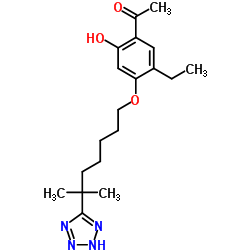5-Lipoxygenase products modulate the activity of the 85-kDa phospholipase A2 in human neutrophils.
J Wijkander, J T O'Flaherty, A B Nixon, R L Wykle
Index: J. Biol. Chem. 270(44) , 26543-9, (1995)
Full Text: HTML
Abstract
Addition of submicromolar concentrations of arachidonic acid (AA) to human neutrophils induced a 2-fold increase in the activity of a cytosolic phospholipase A2 (PLA2) when measured using sonicated vesicles of 1-stearoyl-2-[14C]arachidonoylphosphatidylcholine as substrate. A similar increase in cytosolic PLA2 activity was induced by stimulation of neutrophils with leukotriene B4 (LTB4), 5-oxoeicosatetraenoic acid, or 5-hydroxyeicosatetraenoic acid (5-HETE). LTB4 was the most potent of the agonists, showing maximal effect at 1 nM. Inhibition of 5-lipoxygenase with either eicosatetraynoic acid or zileuton prevented the AA-induced increase in PLA2 activity but had no effect on the response induced by LTB4. Furthermore, pretreatment of neutrophils with a LTB4-receptor antagonist, LY 255283, blocked the AA- and LTB4-induced activation of PLA2 but did not influence the action of 5-HETE. Treatment of neutrophils with pancreatic PLA2 also induced an increase in the activity of the cytosolic PLA2; this response was inhibited by both eicosatetraynoic acid or LY 255283. The increases in PLA2 activity in response to stimulation correlated with a shift in electrophoretic mobility of the 85-kDa PLA2, as determined by Western blot analysis, suggesting that phosphorylation of the 85-kDa PLA2 likely underlies its increase in catalytic activity. Although stimulation of neutrophils with individual lipoxygenase metabolites did not induce significant mobilization of endogenous AA, they greatly enhanced the N-formylmethionyl-leucyl-phenylalanine-induced mobilization of AA as determined by mass spectrometry analysis. Our findings support a positive-feedback model in which stimulus-induced release of AA or exocytosis of secretory PLA2 modulate the activity of the cytosolic 85-kDa PLA2 by initiating the formation of LTB4. The nascent LTB4 is then released to act on the LTB4 receptor and thereby promote further activation of the 85-kDa PLA2. Since 5-HETE and LTB4 are known to prime the synthesis of platelet-activating factor, the findings suggest that 85-kDa PLA2 plays a role in platelet-activating factor synthesis.
Related Compounds
| Structure | Name/CAS No. | Molecular Formula | Articles |
|---|---|---|---|
 |
LY255283
CAS:117690-79-6 |
C19H28N4O3 |
|
Leukotriene B4 Inhibits L-Type Calcium Channels via p38 Sign...
2015-01-01 [Cell Physiol. Biochem. 37 , 1903-13, (2015)] |
|
12-Hydroxyheptadecatrienoic acid promotes epidermal wound he...
2014-06-02 [J. Exp. Med. 211(6) , 1063-78, (2014)] |
|
A leukotriene B4 receptor-2 is associated with paclitaxel re...
2013-07-23 [Br. J. Cancer 109(2) , 351-9, (2013)] |
|
Platelet microparticles are internalized in neutrophils via ...
2015-07-07 [Proc. Natl. Acad. Sci. U. S. A. 112 , E3564-73, (2015)] |
|
Commonly used leukotriene B4 receptor antagonists possess in...
2011-01-01 [Prostaglandins Leukot. Essent. Fatty Acids 84(3-4) , 109-12, (2011)] |